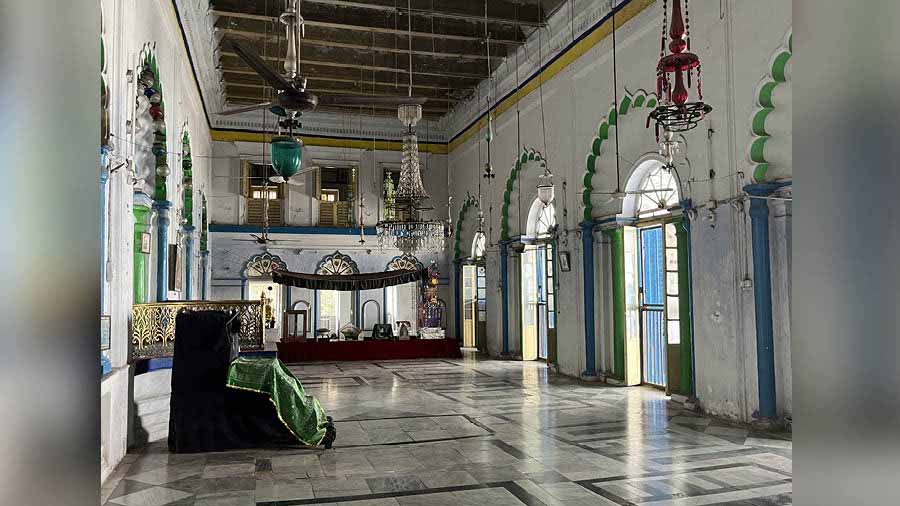A heritage walk and a first-of-its-kind exhibition of archival ink drawings recently paid tribute to Nawab Wajid Ali Shah, the last King of Awadh who was a poet, playwright, dancer and great patron of the arts, in his bicentenary year.
Sibtainabad Imambara in southwest Kolkata’s Metiabruz, the 1864-built structure where the nawab rests, hosted the exhibition titled Intekhab as part of Dastaan e Akhtar, a two-day event curated by visual artist Soumyadeep Roy in collaboration with the descendants of the royal family, Talat Fatima (great great granddaughter of Wajid Ali Shah), Manzilat Fatima (great great granddaughter of Wajid Ali Shah), and Kamran Meerza (great great grandson of Wajid Ali Shah).
Intekhab – The Exhibition
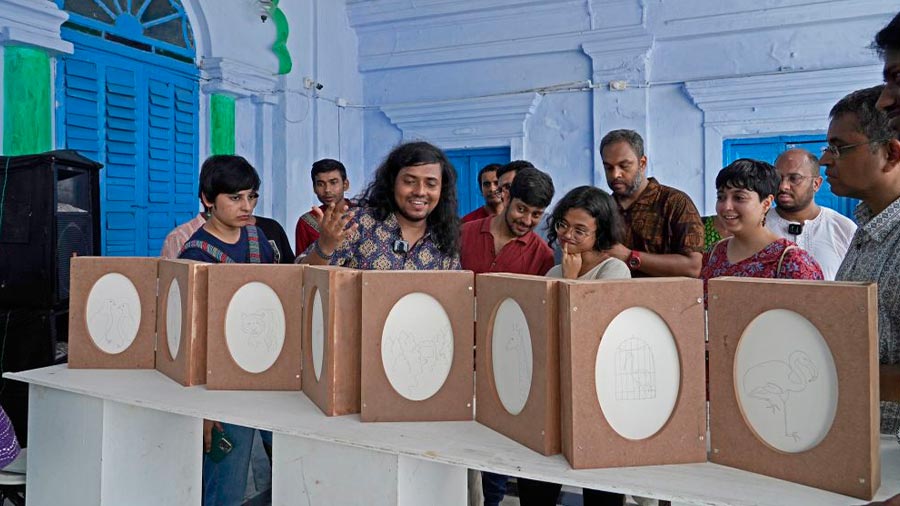
Artist Soumyadeep Roy (third from left) explains his series of minimal archival ink drawings at the exhibition named ‘Intekhab’ at Sibtainabad Imambara
Amitabha GuptaThe Urdu term intekhab literally means ‘a selection’. It is a glimpse into the Nawab's life. The exhibition was done in three parts — Dast e Mubarak (the holy hand), Dastaan e Maahi (A tale told by two fish) and Digress from the Tigress (Stories of the menagerie) — and held over two days, July 15and 16.
Dast e Mubarak
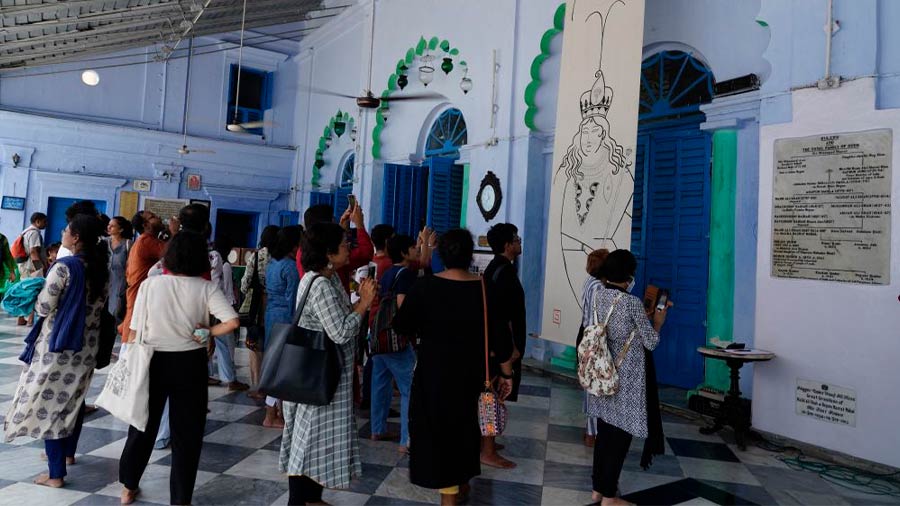
Participants of Heritage Walk look at the 18 feet x 4 feet scroll designed as a tribute to Nawab Wajid Ali Shah at Sibtainabad Imambara
Amitabha GuptaThis large 18ftX4ft scroll is a humble tribute to the great king whose vision influences the present as much as it did the past and, just like the mythical hand Dast e Mubarak, it continues to reign supreme. The artwork was painted at the Imambara itself by Soumyadeep on an 18ftX4ft unprimed canvas as a gift and tribute to the king. The main portrait is flanked by two other scrolls of the angel mermaids (18ftX2ft each), which represent the emblem of Awadh.
Dastaan e Maahi
This work offers a glimpse into the life of Nawab Wajid Ali Shah, told through a series of minimal archival ink drawings. The life of the Nawab is almost symmetrically divided into two halves — the first of which he spent in Lucknow and the second in Kolkata’s Metiabruz. These two halves are divided into two sides of the installation, in the form of a story told by two fish (the emblem of Awadh). The first fish narrates the story of the Nawab’s life in Lucknow. The second section of the tale is told by the fish from Bengal.
Digress from the Tigress
The third section of the installation is a peek into the much-talked about menagerie of the Nawab. It follows stories of the menagerie based on stories from archival documents and archival photographs (by 19th century photographer Fritz Kapp) graciously shared by the descendants of the family with the artist. The minimal line drawings are in consonance with the siyaqalam tradition of painting in Awadh, which would be minimal ink drawings.
The entire exhibition was a tribute to a king who built three kingdoms — the one in Lucknow, the one in Metiabruz and the one he built through his art. While his two former kingdoms were demolished and are in ruins, the third kingdom — that of art — continues to live and grow more and more every day.
Heritage walk revisits era of Wajid Ali Shah
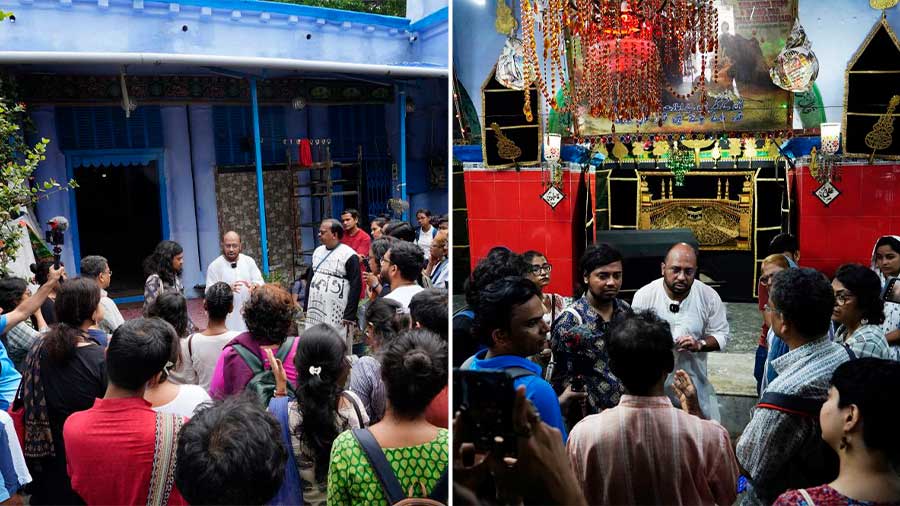
Soumaydeep Roy and Shaikh Sohail talk to heritage walk participants outside Qasr-ul-Buka Imambara built by Akhtar Mahal Sahiba, one of the two ‘nikah’ wives of the nawab at Garden Reach
Amitabha GuptaShaikh Sohail of Break Free Trails and Soumyadeep of Heritage and Art Walks Kolkata started the heritage walk on July 16 from the Garden Reach clock tower, covering remaining structures from the era of Wajid Ali Shah, including the Shahi Astabal Masjid, Qasrul buka Imambara, Bait-un-Nijat Imambara and Sibtainabad Imambara. Most of the imambaras are managed partly by Sibtainabad Trust and private family members. Apart from the Sibtainabad Imambara, rest are in need of public care and support. There are serious efforts needed from Kolkata Municipal Corporation as well as West Bengal Heritage Commission for their restoration and protection.
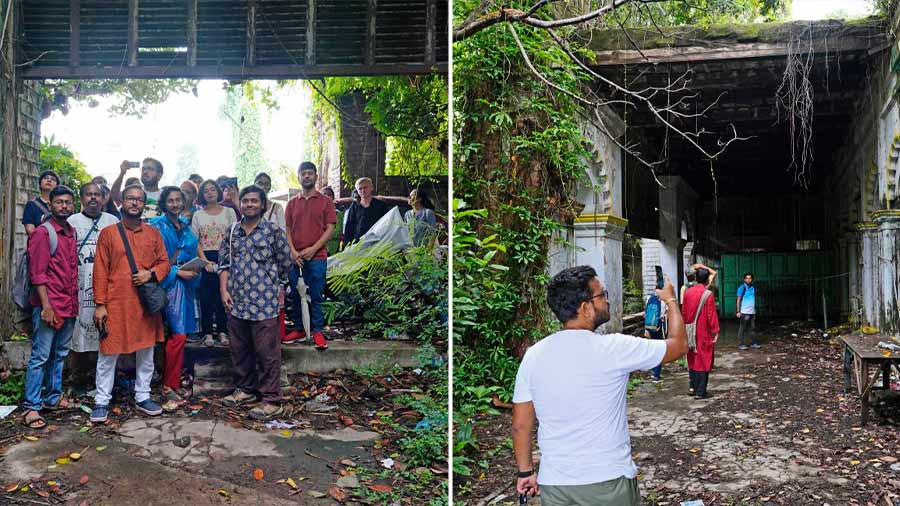
Artist Soumaydeep Roy inside the dilapidated Bait-un-Nijat Imambara during heritage walk and (right) participants of the Heritage Walk taking a look inside Bait-un-Nijat Imambara which was built in 1863 by Nawab Wazid Ali Shah to commemorate Muharram with his family
Amitabha GuptaThe Bait-un-Nijat Imambara, built in 1863 by Nawab to commemorate Muharram, is in a dilapidated condition. Despite the modest exteriors, the interiors of Qasr-ul-Buka Imambara, built by Akhtar Mahal Sahiba — one of the two ‘nikah’ wives of the Nawab at Garden Reach — is a treat to the eyes with its chandeliers, glassware, lamp shades, wall-hangings and carpets. Inside the Imambara of Begum Umda Mahal, one of the wives the Nawab had mentioned in his famed Ishqnama (1850), the walls are covered with vegetal and floral patterns created made of coloured glass which gives a unique dazzling effect.

Participants of Heritage walk take a stroll inside the premises of Shahi Masjid built around 1856-57 meant for personal use of the nawab
Amitabha GuptaProbably the first structure to be constructed by Nawab Wajid Ali Shah at Metiabruz is the Shahi Masjid at Iron Gate Road built around 1856-57 meant for his personal use. A spot near the river through a mud infested path surrounded by warehouses was pointed out by Sohail and Soumyadeep to the 40 and odd participants as the very place where once existed the Sultankhana or the official residence of the Nawab.
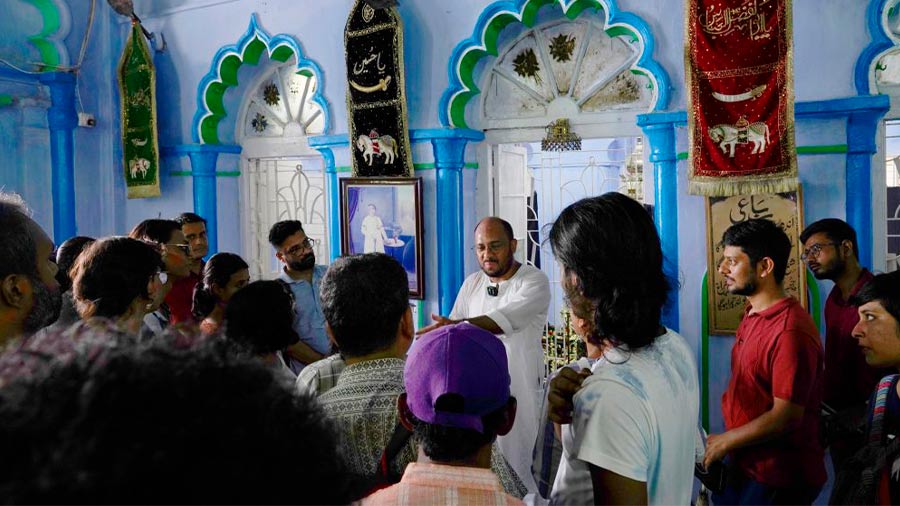
Shaikh Sohail speaks to participants of heritage walk inside Sibtainabad Imambara. Behind the arches is the final resting place of Nawab Wajid Ali Shah
Amitabha GuptaThe last stop was the venue of the exhibition, the Sibtainabad Imambara, a miniature replica of the Bada Imambara of Lucknow and the most celebrated visible reminder of Nawab Wajid Ali Shah in Matiabruz. The Oudh coat of arms may be seen above the main gate. As one enters the main hall of the Imambara, one notices that on the eastern side of the hall, behind three arches is the permanent resting place of Nawab Wajid Ali Shah.
First-hand experience
Bibhabori Bhattacharyya, a student of Class IX at Gokhale Memorial Girls’ School who attended her first heritage walk with her father and maritime researcher Swarup Bhattacharyya, thanked the organisers for giving an opportunity to travel back in time to ‘Chhota Lucknow’.
Speaking about the event ‘Dastaan e Akhtar’, Talat Fatima said it was a memorable and historic event organised at the king’s mausoleum at Sibtainabad Imambara for the first time.
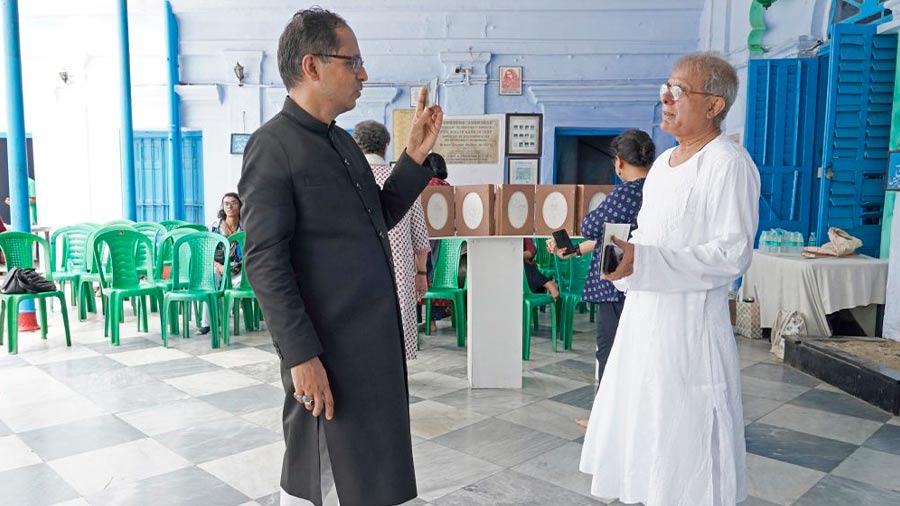
Kamran Meerza (left) interacts with Irfan Muhammad Khan, the descendant of Niyamatullah Khan, a court musician and the ustad of Nawab Wajid Ali Shah who is famed to have designed the sarod
Amitabha GuptaKamran Ali Meerza said the family was deeply touched to see the enthusiasm of the artist Soumyadeep Roy towards the king, he feels for Jaan E Alam as much as the family, if not more. Both members of the Nawab’s family thanked the participants.
Among the participants visiting the exhibition was Irfan Muhammad Khan whose ancestor Niyamatullah Khan was a court musician and the ustad of Wajid Ali Shah and famed to have designed the earlier models of musical instrument sarod. Khan found the event to be beautifully organised and believed efforts should be made to preserve the memory of Wajid Ali Shah and the culture he brought from Lucknow.
Visual artist Soumyajit loved the section dedicated to Wajid Ali Shah’s menagerie and felt that Soumyadeep and Shaikh Sohail transported the audience back to history bringing Wajid Ali Shah’s memory to the 2020s.



